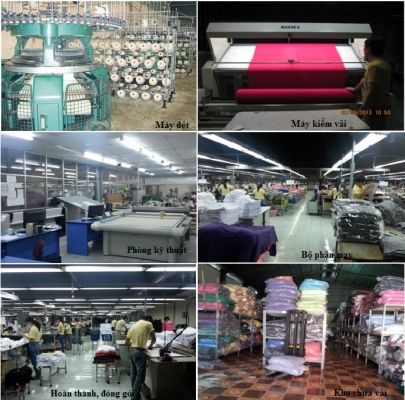Xã hội hiện đại, đời sống của người dân được nâng cao, trẻ em được đầu tư phát triển một cách toàn diện, nhu cầu về thời trang trẻ em cũng ngày càng đa dạng và phong phú với nhiều mặt hàng, mẫu mã. Đáp ứng nhu cầu thiết thực đó, thị trường kinh doanh quần áo trẻ em phát triển một cách nhanh chóng. Để trở thành người kinh doanh có thể cạnh tranh tốt trong lĩnh vực này, bạn cần chọn cho mình một nguồn nhập, đối tác chuyên bán sỉ và bán buôn quần áo trẻ em uy tín với chất lượng và giá thành tốt nhất.
Figure 1 Thời trang trẻ em ngày càng đa dạng và phong phú
Nếu bạn kinh doanh quần áo trẻ em và còn đang băn khoăn không biết chọn đối tác nào có thể hoàn toàn tin tưởng, thì KIMNAMS là sự lựa chọn hàng đầu.
Sau nhiều năm hoạt động kinh doanh bán buôn quần áo trẻ em, Kimnams đã trực tiếp thiết kế và sản xuất riêng các mẫu quần áo trẻ em sử dụng 100% chất liệu cotton thoáng mát, dễ thấm mồ hôi. Hưởng ứng người Việt dùng hàng Việt, chúng tôi tập trung sản xuất các sản phẩm “made in Việt Nam” chất lượng đảm bảo và giá thành phù hợp với người tiêu dùng . Sản phẩm hiện cóđược chia làm 3 dòng hàng gồm: hàng xuất dư, hàng may gia công của Kimnams hoặc các công ty khác và dòng hàng nhập khẩu.
Hàng Kimnams sản xuất là các loại hàng được thiết kế và sản xuất riêng mẫu mã, chất liệu và thương hiệu được gắn theo nhãn mác của Kimnams phân phối, hàng xuất dư là các loại hàng thu mua ở các nhà máy xuất khẩu hay các chủ chuyên cung cấp loại hàng này, hàng nhập khẩu gồm các loại hàng của các hãng nước ngoài Kimnams làm đại lý phân phối tại Việt Nam.
Ngoài ra, Kimnams là cơ sở phân phối len trẻ em hm toàn miền Bắc, độc quyền phân phối len trẻ em momma 2-10t…
Figure 2 Bán buôn quần áo trẻ em VNXK với dây chuyền tự sản xuất
Tại sao có thể tin tưởng lựa chọn Kimnams?
Xã hội ngày càng phát triển, chất lượng sản phẩm thời trang trẻ em càng được người tiêu dùng quan tâm nhiều hơn.Vài năm trở lại đây, người tiêu dùng Việt Nam đã có cái nhìn mới về thời trang, không chỉ ở giá thành và mẫu mã, họ yêu cầu cao hơn cả về chất lượng, nguồn gốc.
Nhằm đáp ứng nhu cầu khách hàng, theo kịp tốc độ phát triển của xã hội, chúng tôi đã nhập khẩu hàng chất lượng cao của nhiều hãng với nguồn gốc đa dạng như Thái Lan, Campuchia, Trung Quốc.
Thời trang trẻ em xuất khẩu trong những năm gần đây được ưa chuộng do chất lượng tốt, sản xuất theo tiêu chuẩn quốc tế, giá thành phải chăng và sản xuất tại Việt Nam. Chúng tôi đã trực tiếp sản xuất hàng VNXK “Made in Việt Nam” tại thành phố Hồ Chí Minh, tiếp tục mở rộng quy mô sản xuất tại miền Bắc hợp tác với nước ngoài, đẩy mạnh hợp tác với các hãng trong nước như thương hiệu thời trang Dumy Kids. Sản phẩm của Dumy Kids với mẫu mã đa dạng, gồm quần áo trẻ em cho bé trai, quần áo trẻ em cho bé gái, quần áo trẻ sơ sinh và thời trang trẻ em nhập khẩu. Chúng tôi cam kết an toàn cho bé với những đặc điểm nổi bật là chất liệu 100% cotton, bền đẹp, không xù, bạc màu và vỡ hình in… Sản phẩm được bảo hành 1 năm. Năm 2014, thời trang trẻ em Dumy Kids đã được người tiêu dùng bình chọn là sản phẩm an toàn và là dịch vụ vàng cho bé.
Ngoài ra, Kimnams hợp tác với các xưởng sản xuất chuyên hiệu xuất khẩu Oshkosh, Place, Gap… thu mua hàng nguyên lô xuất dư, đảm bảo 100% mã code xuất khẩu.
Liên kết với Kimnams sẽ có quyền lợi gì?
Chúng tôi cam kết hàng hóa đều do Kimnams sản xuất trực tiếp và nhập khẩu trực tiếp không qua trung gian. Hàng Kimnams là đại lý độc quyền hoặc đại lý cấp 1 của các hãng sẽ có giá thấp hơn giá thị trường đang bán ra. Do vậy khách hàng hoàn toàn yên tâm với giá thành ở mức tốt nhất.Đối với khách hàng mua nguyên lô, Kimnams đảm bảo mẫu chưa được bán cho người khác và giá của lô hàng đó.
Một số chính sách ưu đãi dành cho khách hàng: vận chuyển miễn phí trong nội thành Hà Nội đơn hàng từ 10 triệu VNĐ, hỗ trợ phí ship giá ưu đãi đối với khách hàng ở xa, hàng lỗi được đổi trả trong khoảng 20 ngày, hàng do Kimnams sản xuất có chất lượng kém sẽ được hoàn tiền hoặc đổi lại hàng. Chúng tôi đảm bảo bất kì một loại sản phẩm Kimnams nào có giá cao hơn so với giá trên thị trường đang bán 2000 VNĐ sẽ được hoàn tiền hoặc đổi hàng khác.
Mọi nhu cầu hợp tác phân phối vui lòng liên hệ với chúng tôi:
 RSS Feed
RSS Feed Twitter
Twitter






 9:37:00 AM
9:37:00 AM
 Lê Hữu Nam
Lê Hữu Nam









